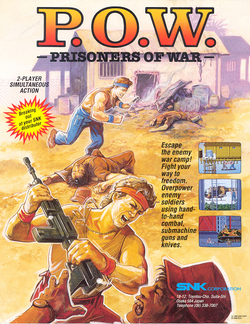- P.O.W.: Prisoners of War
-
P.O.W.: Prisoners of War 
U.S. arcade flyer of P.O.W.: Prisoners of War.Developer(s) SNK Publisher(s) SNK
ElectrocoinPlatform(s) Arcade, NES Release date(s) 1988 Genre(s) Beat 'em up Mode(s) Single player, 2 player Co-op Cabinet Upright Display Raster, 256 x 224 pixels (Horizontal), 2048 colors P.O.W.: Prisoners of War (脱獄 Datsugoku, "Prison Break") is a side-scrolling beat 'em up produced by SNK originally released as an arcade game in 1988. A home version was released for the Nintendo Entertainment System on June 30, 1989 in Japan and on September 1989 in North America. The player controls a military prisoner who breaks free from his cell and must fight his way into the enemy's main base in order to eliminate their leader and escape.
Contents
Arcade version
The arcade version of P.O.W. can be played by up to two players simultaneously. Player 1 controls a prisoner dressed in blue, while Player 2 controls one in red. The objective is to escape from the enemy's base by fighting their way through four stages filled with numerous soldiers trying to impede the player's escape. The stages consist of a POW camp, a warehouse, a jungle, and the enemy's base. Enemies includes foot soldiers, commandos, and green berets.
The controls consists of an eight-way joystick for moving the character and three action buttons for punching, kicking, and jumping. There are also three special attacks performed by pressing two buttons in combination: a jump kick (jump, and then kick), a back punch (jump and punch simultaneously), and a headbutt (punch and kick simultaneously). The player can also pick up one of two weapons dropped by defeated enemies: a throwing knife and a machine gun. When wielding the machine gun, the player can fire it by pressing the kick button or conserve its ammo by pressing the punch button to swing its butt at enemies.
NES version
Unlike the arcade version, the NES version is single-player only. The premise of the game remains the same, but the controls are changed a bit due to the lack of a third action button. The jump kick is now performed by pressing punch and kick simultaneously (B and A), while the back-punch is performed by holding the d-pad on the player's opposite direction and pressing B at the same time (the headbutt is the only combination attack removed in the NES version). However, the player now has the ability to pick up and use hand grenades (which were only used by enemy characters in the arcade version) during the boss encounters against the helicopter in Stage 1 and the tank in Stage 4. There are also new enemy characters (such as frogmen, shotgun wielders, and a fat strongman), as well as a new final boss.
There also huts and rooms where the player can obtain power-ups by defeating the enemies inside. The power-ups consists of a full life recovery, a brass knuckle that increases the player's attack strength, and an armor that makes the player invulnerable to gunshots and knife throws.
References
- Instructions from the arcade version's bezel.
- P.O.W. Instruction Manual.
External links
Categories:- 1988 video games
- Arcade games
- Nintendo Entertainment System games
- SNK games
- Beat 'em ups
Wikimedia Foundation. 2010.
